Genre: Sports Developer: Anco/Tiertex Publisher: US Gold Players: 1 Released: 1993
In the world of video games there are a handful of companies that can be considered to be one-hit wonders: While the majority of their titles are now lost in obscurity due to their lack of quality or mediocrity, they are remembered for that one game that managed to stand out and became a surprisingly huge success. One of these companies was a little known British development team called Anco. In 1989, the company landed one of the most surprising successes of the 16-bit home computer era: A fast, frantic, and furious soccer game called Kick-Off. The game (and its sequel, Kick-Off 2) quickly rose to become one of the most popular soccer games among the Atari ST- and Amiga-crowd (until Sensible Soccer rolled along) and was one of the first computer games in which large-scale tournaments were held. Its creator, Dino Dini (a man with the most ridiculous and most awesome name in computer development ever) practically became famous overnight.
The first Kick-Off games (including the Genesis incarnation) were played in a top down perspective. However, other than in most soccer games at the time, the ball didn’t stick with the player but rather rolled along ahead of him – if the player wanted to change direction with the ball, he had to stop it first, or pass it along. This, combined with fast speed, made the game more realistic than other soccer games of the day. Anco improved the formula for the sequel and added a few other elements: Referees who are either more lenient or rigorous when it came to fouls (and who were discernible by name) and the ability to edit teams were a few of them. The sequel became an even greater success than its predecessor: Easy to access, but hard to master, it provided a lot of bang for its buck. Riding on the wave, Anco kept pumping out soccer and soccer manager games. And since consoles were starting to challenge the Atari- and Amiga home computers (which in the ’80s and way into the ’90s were still the favorite gaming platforms in Europe), the decision was made to port the successful series over to the Sega- and Nintendo crowd as well. Hence, Super Kick-Off was born, though the port wasn’t done by Anco themselves, but rather by Tiertex – a British software house that was mostly known for their ports. Unfortunately, they weren’t known for doing quality jobs.
Also, word is that the creator of the game mechanic, Dino Dino, didn’t work at all at the port, as he was already on his way out (he would later create the game “Goal!” for Virgin, which is a way more accurate copy of the home computer Kick-Off games). So the honor of overseeing the port fell to the graphics designer, Steve Screech. And to be fair, even fans of the home computer version of Kick-Off 2 admit that the graphics look nice, even a tad nicer than the original. However, being able to pull off good looks doesn’t guarantee a good game design.
Those who play Super Kick-Off for the first time will probably be highly confused by the gameplay. The main focus of the game lies on dribbling, and this is a rather tough technique to master. While running, you can only shoot or pass the ball when a player touches it with the foot – if it’s too far ahead of you it simply won’t work. Sudden changes of direction can also only be accomplished when a player explicitly touches the ball, otherwise it just keeps rolling its course. The B-button, therefore, will become the most important button in the game: By pressing B, you are able to stop the ball, so afterwards you can shoot it low or high (by pressing A or C respectively), or run along in a different direction. However, the pace of the game is pretty fast, so you have to be very quick about it or you have to chase after your opponent again. Not only does splitting the controls over three buttons complicate matters a bit (the original games had to make do with only one button and managed to pull off a decent game), the controls feel off, as if they were slightly delayed. Stopping a ball can become a bit of a gamble, and if you want to give off a controlled shot you need to stop the ball by pressing B and immediately pressing A afterwards. Needless to say, most of the time you end up mashing at the buttons and hoping the ball goes roughly in the intended direction.
While you only see a small portion of the pitch which is centered on the ball, a radar screen on the top left shows the approximate positions of every player. At first the screen might seem more distracting than helpful since it takes up roughly 1/3rd of the field of sight. Via the pause menu it can (and probably should) be reduced in size or turned off altogether, since when playing at full speed, constantly glancing at the radar while trying to keep in control of the ball might prove to be a bit of a problem.
Needless to say, the gameplay mechanic is pretty tough to master. Luckily, the developers included a couple of options to make things a bit easier. First, there’s a training mode, where newcomers can practice dribbling, standard situations like corner kicks and penalties – highly recommended for anyone who first lays hands on the game. Secondly, you can choose three different speed settings in the options menu. Since the game is set on the highest one per default, someone playing the game for the first time should rather turn down the pace and practice for a while before taking on the computer. Other options are more common, like setting the clock (2×3, 2×5, 2×10 or 2×20 minutes), switching the offsides-rule on or off, or turning off the referee and playing without penalties.
The game was a tough one even in its original incarnation, and the most fun was drawn out of playing against another human. The computer opponent is very tough, no matter what team he is playing with, but in vs. mode the fast and frantic gameplay gave the experience a hectic, almost anarchic note, and matches on home computers became a somewhat exiting, if sometimes frustrating, mashfest. However, some of that excitement is lost in translation on the Genesis. The problem is that the controls feel way too loose. There seems to be a slight delay between button presses and on-screen action, and while it’s tolerable on the lowest speed setting, even the slightest lag massively disrupts the gameplay experience at full speed. Even with some training it will take a very long time until this game feels anything but totally out of control.
While Kick-Off certainly was a fresh and exciting new experience when it around 1990, the video game formula for soccer has been improved on since. Looking back on the game now, it has long since been surpassed by others in the genre, most importantly by the Sensible Soccer series of games which arrived only shortly afterwards in the 16-bit era. It will take a lot of training and a lot of nerves until the game becomes a more enjoyable experience – other soccer games are easier to access. Not only has the game aged badly, but the controls also lack the tightness of its home computer archetypes – even fans of the home computer games have some trouble getting a hang of the Mega Drive controls. Thus its biggest strength, the two-player vs. mode, leaves something to be desired. What was once a fun if somewhat chaotic battle demanding a high amount of skill on home computers has become a frustrating, hard to control button masher in its console incarnation. There is still a certain amount of fun to be had while playing against a human opponent, but even then it’s harder to play than it should be. If you’re looking for a fun soccer game for the Genesis, take my advice and pick Sensible Soccer instead.
SCORE: 4 out of 10

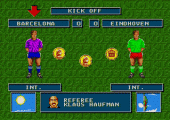
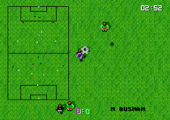
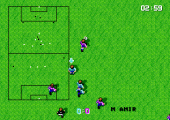
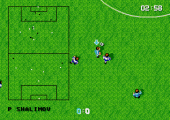
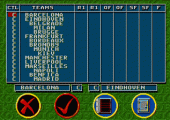
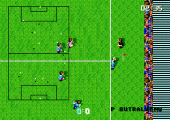
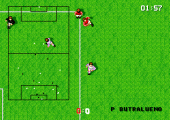
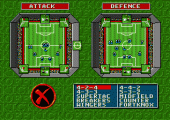
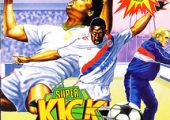
Absolutely woeful game, avoid like the plague!